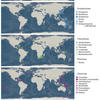Abstract:
Fissurellidae are marine gastropods with a worldwide distribution and a rich fossil record. We integrate molecular, geographical and fossil data to reconstruct the fissurellid phylogeny, estimate divergence times and investigate historical routes of oceanic dispersal. With five molecular markers for 143 terminals representing 27 genera, we resolve deep nodes and find that many genera (e.g., Emarginula, Diodora, Fissurella) are not monophyletic and need systematic revision. Several genera classified as Emarginulinae are recovered in Zeidorinae. Future work should prioritize emarginuline genera to improve understanding of ancestral traits and the early evolution of fissurellids. Tree calibration with the FBD model indicates that crown fissurellids originated around 175 Ma, and generally resulted in younger ages for the earliest nodes than the node dating approach. Model-based biogeographic reconstruction, supported by fossils, infers an Indo-West Pacific origin, with a westward colonization of new oceans via the Tethys Seaway upon the breakup of Pangea. Western Atlantic clades then served as source for dispersal towards other parts of the globe. As the sister group to all other fissurellids, Rimula is ranked in its own subfamily, Rimulinae stat. nov. New synonyms: Hemitominae syn. nov. of Zeidorinae stat. nov.; Cranopsis syn. nov. of Puncturella; Variegemarginula syn. nov. of Montfortula.
Publisher's Version



